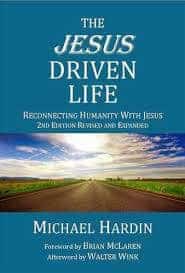 Today begins a 4-part series by Michael Hardin, “How Jesus Read His Bible.” Hardin is the co-founder and Executive Director of Preaching Peace a non-profit based in Lancaster, PA whose motto is “Educating the Church in Jesus’ Vision of Peace.” An internationally known speaker, he is one of the earliest members of the Colloquium on Violence and Religion and is a co-founder Theology and Peace, also based in the United States. Michael was educated at North Park Theological Seminary in Chicago and is a PhD candidate at Charles Sturt University in Canberra, Australia.
Today begins a 4-part series by Michael Hardin, “How Jesus Read His Bible.” Hardin is the co-founder and Executive Director of Preaching Peace a non-profit based in Lancaster, PA whose motto is “Educating the Church in Jesus’ Vision of Peace.” An internationally known speaker, he is one of the earliest members of the Colloquium on Violence and Religion and is a co-founder Theology and Peace, also based in the United States. Michael was educated at North Park Theological Seminary in Chicago and is a PhD candidate at Charles Sturt University in Canberra, Australia.
Hardin is the author of the acclaimed The Jesus Driven Life and What The Facebook?: Posts from the Edge of Christendom
, and co-editor of Stricken by God?: Nonviolent Identification and the Victory of Christ
, Peace Be with You: Christ’s Benediction amid Violent Empires
, Compassionate Eschatology
, and editor of the forthcoming book Reading the Bible with Rene Girard. He is currently book project is Lamb Up!: The Resurrection Gospel. He has published over a dozen articles on the mimetic theory of René Girard in addition to essays on theology, spirituality and practical theology. Michael participated in the recent documentary Hellbound?
and is working with director Kevin Miller on a television project on the work of René Girard.
These posts are adapted by Hardin from The Jesus Driven Life.
*****************
We have learned from modern theologians that what one says about Scripture and how one uses it can be two different things and that how one uses Scripture is the real indication of what one believes about it.
I notice, for example, that many preachers use Scripture as a diving board, they quote it and then jump off into a pool of ideas, leaving the biblical text behind. What they say might be good or true or even relevant but it has little or no connection to the passage under discussion.
Other preachers I have heard treat Scripture like they are in a 7th grade science class dissecting a frog. They notice with some repugnance the things they don’t like and can be quite critical of the process of having to figure out what lies before them.
Some have a high view of Scripture by which they mean Scripture is the Word of God, inspired and without error, yet the way in which they use it betrays that they really don’t take it very seriously. These folks ignore context and a text without a context is a pretext or as my Australian friend Jarrod McKenna says “a text without a context is a con.”
These folks have what I call the Old McDonald approach to the Bible, here a verse, there a verse, everywhere a verse verse. Contemporary fundamentalist preaching is like this; a string of verses on a chain like pearls that all make whatever point the preacher is seeking to get across.
That makes the Bible flat and you can do all kinds of strange things with a flat Bible. It’s like silly putty. A flat reading of the Bible is like a 2D grainy black and white silent film compared to reading the Bible on a Hi-Def BIG HDTV screen with Blu-Ray color and Bose Surround Sound in 4D. Now what would you rather have? A thin schemer of old butter on cold toast or a rich robust Feast?
There is a way to read the Bible that is life-giving, thoughtful and joyous. How Scripture is deployed says a lot more than what is believed about it. Believing something to be true about the Bible does not make it true no matter how many have shouted it.
What counts, ultimately, is the way the Bible is rendered in your life, that is, how your life is the living interpretation of the Bible.
Protestants frequently argue that because Jesus quoted the Jewish Bible, this means that he accepted its authority as a whole. When they do this they import a modern view of the authority of Scripture or canon back into the past.
The fact is that there were many and varied views of the authority of the biblical writings and not all groups in Jesus’ time had the same view of biblical authority. It is also true that the way the New Testament writers and Jesus quote and interpret Scripture follows certain patterns in their culture.
Groups in Jesus’ day had rules or guidelines for interpreting the biblical text. The key question for us and one that is rarely raised is this: Did Jesus have a way of using his Bible that was different from those around him? I suggest that he did.
The key text for us to explore in this section will come from Jesus’ inaugural sermon at his hometown synagogue in Nazareth found in the Gospel of Luke (4:16-30).
To be fair, many critical scholars see the hand of the Gospel editor all over this text, noting that many phrases are typical of Luke. Nevertheless, I suspect that there is an authentic story underlying this text inasmuch as Jesus’ first sermon almost gets him killed.
There is also a tremendous congruity with how Jesus interprets the Scripture in this text and his way of understanding both theology and ethics that we find in his teaching, e.g., in the Sermon on the Plain (Luke 6).
In Luke 4 Jesus returns to his hometown in Nazareth after having been baptized and then tested in the wilderness. He enters the synagogue and is asked to be the Scripture reader.
In Jesus’ day this could have taken two forms, the first is the actual reader (vocalizer) of the Hebrew text that would not have been understood by Galileans. It would be like someone reading from the Greek New Testament in church today.
The second role would be that of a translator/interpreter known as a targumist. This person would not read from a scroll but recite from memory a ‘standard’ translation (a Targum) in Aramaic that was the common Semitic tongue in Palestine. Luke appears unclear as to which role Jesus took, perhaps conflating both roles into one. Nevertheless in Luke, Jesus arises takes the scroll and reads from Isaiah:
“The Spirit of the Lord is on me, because he has anointed me to preach good news to the poor. He has sent me to proclaim freedom for the prisoners and recovery of sight for the blind, to release the oppressed, to proclaim the year of the Lord’s favor.”
After this he rolls the scroll up, hands it over to the attendant, who puts it away and then Jesus sits down. The sermon was short and sweet. He says, “Today this text has been fulfilled in your hearing.”
this text has been fulfilled in your hearing.”
Now what follows is strange for at first it appears that the listeners are quite glad for what Jesus said. But he retorts rather sarcastically and then proceeds to cite two examples (Elijah and Elisha) to justify his sarcasm. It is at this point that the crowd wants to take him out and kill him by throwing him off a cliff.
This really doesn’t make much sense. Some interpreters might argue that what got Jesus in trouble was some sort of ‘divine’ claim, that God had anointed him to be special. But is such the case?
In my next post, in order to see what is happening here in Luke 4, we shall note three critical but interrelated aspects of this episode. First, we will note the way Jesus cites the book of Isaiah compared to what is actually in Isaiah. Second, we will look at the translation problem of verse 22. Third we will look at why Jesus uses these specific examples from Elijah and Elisha to make his point.
